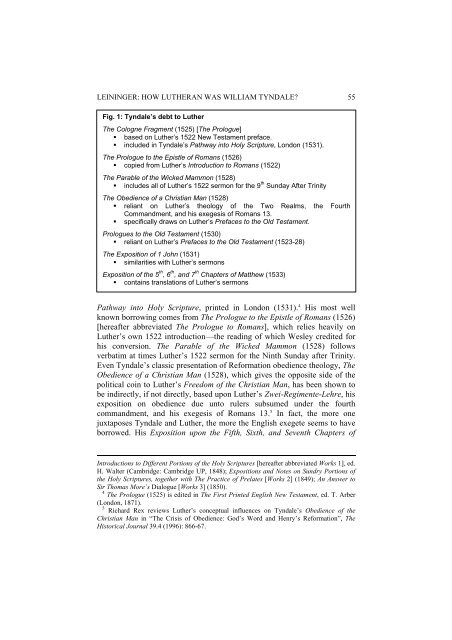LUTHERAN THEOLOGICAL REVIEW - Brock University
LUTHERAN THEOLOGICAL REVIEW - Brock University
LUTHERAN THEOLOGICAL REVIEW - Brock University
You also want an ePaper? Increase the reach of your titles
YUMPU automatically turns print PDFs into web optimized ePapers that Google loves.
LEININGER: HOW <strong>LUTHERAN</strong> WAS WILLIAM TYNDALE 55<br />
Fig. 1: Tyndale’s debt to Luther<br />
The Cologne Fragment (1525) [The Prologue]<br />
• based on Luther’s 1522 New Testament preface.<br />
• included in Tyndale’s Pathway into Holy Scripture, London (1531).<br />
The Prologue to the Epistle of Romans (1526)<br />
• copied from Luther’s Introduction to Romans (1522)<br />
The Parable of the Wicked Mammon (1528)<br />
• includes all of Luther’s 1522 sermon for the 9 th Sunday After Trinity<br />
The Obedience of a Christian Man (1528)<br />
• reliant on Luther’s theology of the Two Realms, the Fourth<br />
Commandment, and his exegesis of Romans 13.<br />
• specifically draws on Luther’s Prefaces to the Old Testament.<br />
Prologues to the Old Testament (1530)<br />
• reliant on Luther’s Prefaces to the Old Testament (1523-28)<br />
The Exposition of 1 John (1531)<br />
• similarities with Luther’s sermons<br />
Exposition of the 5 th , 6 th , and 7 th Chapters of Matthew (1533)<br />
• contains translations of Luther’s sermons<br />
Pathway into Holy Scripture, printed in London (1531). 4 His most well<br />
known borrowing comes from The Prologue to the Epistle of Romans (1526)<br />
[hereafter abbreviated The Prologue to Romans], which relies heavily on<br />
Luther’s own 1522 introduction—the reading of which Wesley credited for<br />
his conversion. The Parable of the Wicked Mammon (1528) follows<br />
verbatim at times Luther’s 1522 sermon for the Ninth Sunday after Trinity.<br />
Even Tyndale’s classic presentation of Reformation obedience theology, The<br />
Obedience of a Christian Man (1528), which gives the opposite side of the<br />
political coin to Luther’s Freedom of the Christian Man, has been shown to<br />
be indirectly, if not directly, based upon Luther’s Zwei-Regimente-Lehre, his<br />
exposition on obedience due unto rulers subsumed under the fourth<br />
commandment, and his exegesis of Romans 13. 5 In fact, the more one<br />
juxtaposes Tyndale and Luther, the more the English exegete seems to have<br />
borrowed. His Exposition upon the Fifth, Sixth, and Seventh Chapters of<br />
Introductions to Different Portions of the Holy Scriptures [hereafter abbreviated Works 1], ed.<br />
H. Walter (Cambridge: Cambridge UP, 1848); Expositions and Notes on Sundry Portions of<br />
the Holy Scriptures, together with The Practice of Prelates [Works 2] (1849); An Answer to<br />
Sir Thomas More’s Dialogue [Works 3] (1850).<br />
4 The Prologue (1525) is edited in The First Printed English New Testament, ed. T. Arber<br />
(London, 1871).<br />
5 Richard Rex reviews Luther’s conceptual influences on Tyndale’s Obedience of the<br />
Christian Man in “The Crisis of Obedience: God’s Word and Henry’s Reformation”, The<br />
Historical Journal 39.4 (1996): 866-67.













